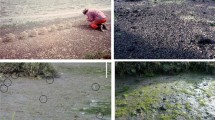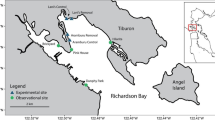Abstract
Once a marine invader has become established, its subsequent control has rarely been attempted. We report the first apparently successful eradication of a locally well-established introduced marine pest. A previously unknown species of sabellid polychaete (now described as Terebrasabella heterouncinata arrived as an epizoic contaminant on South African abalone imported to California for commercial aquaculture research. In 1996, we detected an established sabellid population at an intertidal site near Cayucos, California (35 °45'N, 120 °95'W). To mitigate the impact of this introduced marine pest at this site, and prevent or slow its geographic spread, we proposed an eradication program based on the epidemiological theory of the threshold of transmission. Specifically, we removed 1.6 million of the most highly susceptible and preferred host in the intertidal area; the black turban snail, Tegula funebralis. A screen was also installed at the associated abalone mariculture facility to eliminate release of additional infested material (the source of the established sabellid population) and all such material was removed from the intertidal area. Using transect surveys and mark and recapture studies, we monitored the success of the eradication effort. Transmission of the pest can no longer be detected. Hence, the established sabellid population has apparently been eradicated. This discovery demonstrates that some alien marine pests can be eradicated and supports development of new proactive approaches to the management of other exotic marine pests.
Similar content being viewed by others
References
Bailey NTJ (1957) The Mathematical Theory of Epidemics. Hafner, New York, 194 pp
Carlton JT and Geller JB (1993) Ecological roulette: the global transport of nonindigenous marine organisms. Science 261: 78–82
Cohen AN and Carlton JT (1998) Accelerating invasion rate in a highly invaded estuary. Science 279: 555–558
Culver CS (1999) The aperture of marine gastropods: factors precluding settlement of fouling organisms. PhD Dissertation, University of California, Santa Barbara, 127 pp
Culver CS, Kuris AM and Beede B (1997) Identification and management of the exotic sabellid pest in California cultured abalone. California Sea Grant College Program, La Jolla, Publication No. T-041, 29 pp
Davis GE, Haaker PL and Richards DV (1998) The perilous condition of white abalone Haliotis sorenseni, Bartsch, 1940. Journal of Shellfish Research 17(3): 871–875
Durfee PT (1978) Incidence and prevalence defined. Australian Veterinary Journal 54: 405–406
Fitzhugh K and Rouse GW (1999) A remarkable new genus and species of fan worm (Polychaetea: Sabellidae: Sabellinae) associated with some marine gastropods. Invertebrate Biology 118(4): 357–390
Kuris AM and CS Culver (1999) An introduced sabellid polychaete pest of cultured abalone and its potential spread to other California gastropods. Invertebrate Biology 118(4): 391–403
Kuris AM and Lafferty KD (1994) Community structure: larval trematodes in snail hosts. Annual Review Ecology and Systematics 25: 189–217
Margolis L, Esch GW, Holmes JC, Kuris AM and Schad GA (1982) The use of ecological terms in parasitology. Journal of Parasitology 68: 131–133
McKendrick A (1940) The dynamics of crowd infections. Edinburgh Medical Journal (N. Ser.) 47: 117–136
Oakes FR and Fields RC (1996) Infestation of Haliotis rufescens shells by a sabellid polychaete. Aquaculture 140: 139–143
Office of Technology Assessment (OTA), U.S. Congress (1993) Harmful non-indigenous species in the United States, OTA-F-565. Government Printing Office, Washington, DC, 391 pp
Onstad DW, Maddox JV, Cox DJ and Kornkven EA (1990) Spatial and temporal dynamics of animals and the host-density threshold of epizootiology. Journal of Invertebrate Pathology 55: 76–84
Ruck KR and Cook PA (1998) Sabellid infestations in the shells of South African molluscs: implications for abalone mariculture. Journal of Shellfish Research 17: 693–699
Stiven AE (1964) Experimental studies on the host parasite system hydra and Hydramoeba hydroxena (Entz). II. The components of a single epidemic. Ecological Monograph 34: 119–142
Stiven AE (1968) The components of a threshold in experimental epizootics of Hydramoeba hydroxena in populations of Chlorohydra viridissima. Journal of Invertebrate Pathology 11: 348–357
Rights and permissions
About this article
Cite this article
Culver, C.S., Kuris, A.M. The Apparent Eradication of a Locally Established Introduced Marine Pest. Biological Invasions 2, 245–253 (2000). https://doi.org/10.1023/A:1010082407254
Issue Date:
DOI: https://doi.org/10.1023/A:1010082407254




